|
[Front Page] [Features] [Departments] [SGAP Home Page] [Subscribe]

Australian Plants in their own Garden
Bush Tales from the northern Flinders Ranges
Horst Weber
In September 1997 I spent four weeks at Arkaroola, a private nature reserve in the northern Flinders Ranges, South Australia. During those weeks of field work on plants in semi-arid regions, I spent a lot of time on Acacia Ridge, an 8 km marked walking trail, as well as a perfect native garden.
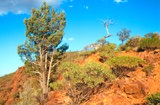 |
Acacia Ridge, Arkaroola, Northern Flinders Ranges; 8 km walking trail with a good variety of plants.
Select the thumbnail image or highlighted phrase for a higher resolution image (51k).
Photo: Horst Weber
|
Dust was choking everything. Although no more but a fine, translucent veil, carelessly discarded by the wind, it held the country in an iron grip, firmly imposing a mood of its own. Right now the late afternoon sun should have painted the jagged mountain ridges and meandering creek beds in vivid, emotional colours. Yet its magic had been broken, its rays rendered powerless by by a flexible, inescapable light mesh of dust.
Sensing the powdery dust on my lips, feeling its grains in eyes, ears and nose I considered my project. Four weeks of field work on plants, photographs, drawings and notes presented quite a challenge to a non-botanist like myself. Yet these parched leaves and shrivelled fruit were more than I had bargained for. Would I be able to develop my compilation of plants profiles for a small book?
"We had a few drops of rain last night, and more persistent rain has been forecast for the next few days. That should wash this dust away!" Raelene had read my thoughts. Arkaroola's helpful manageress showed me my accommodation and left with a smile: "Just wait and see. The dust will wash off and everything will spring to life, no worries!"
Right enough, less than a week separate the charming tune of fat drops on corrugated iron from signs of change. Elbowing from underneath shoe-sized boulders, tiny yellow flowers emerge along freshly moistened creek beds. Shortly afterwards Australian bugle (Ajuga australis) flashes its deep blue against a backdrop of sand, boulders and bright yellow Showy groundsel (Senecio magnificus). Nearby tall, slim Sturt's nightshade, or Targomindah nightshade, (Solanum sturtianum) reach upwards, gently swaying in the wind, ever so evasive of the camera lens.
|

|
Australian
bugle, Ajuga australis
Select the thumbnail
image or plant name for a higher resolution
image (48k).
Photo: Horst Weber
|
"Explore Acacia Ridge", Lorraine Edmunds, Arkaroola's former information officer had suggested. "You will find all the plants you are looking for and heaps more!" The razor-like ridge climbs steeply eastwards, forming a unique, linear, native garden. Sharp-edged rocks and near vertical drops on its shady southern side create multiple pockets of micro-climates. Thus, only a few feet away from the sun-scorched northern slope, ferns like Woolly cloak fern (Cheilanthes lasiophylla) happily unravel their spiral heads.
At its start, as the track climbs out of the creek bed and turns east I find myself accompanied by a community of acacias, mainly Mulga (Acacia aneura), Dead finish, Elegant wattle (A. victoriae) and Silver wattle (A. rivalis). Some trees stretch one or two bare, naked, dead branches high into the sky; cruel evidence of goat damage. Occasionally these dead remains have become a useful support structure for the climbing Native pear (Leichhardtia australis).
|
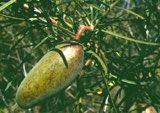
|
Native
pear, Leichhardtia australis.
Select the thumbnail
image or plant name for a higher resolution
image (31k).
Photo: Horst Weber
|
Moving on I nearly would have strolled past a very unglamorous, messy little bush with just one pale-white spot in it. One flower only, but what a flower! Let's do away with all this regular arrangement of petals! We don't want anything circular! Let's be different, let's go for half-circles! The Spiny fan flower (Scaevola spinescens) has decided to arrange all its petals in a bottom half-circle. One could nearly be forgiven for thinking that the top half of the flower has been eaten away! It has not.
|
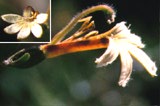
|
Spiny fan
flower, Scaevola spinescens.
Select the thumbnail
image or plant name for a higher resolution
image (30k).
Photo: Horst Weber
|
Turning around my eye is caught by a dot of a deep red glow, a Leafless cherry (Exocarpos aphyllus). Illuminated by the morning sun is a red swelling at the base of a greenish-black fruit, misleadingly giving the impression that one is looking at a half-eaten fruit with a stone sticking out.
|
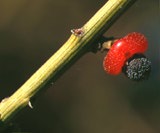
|
Fruit of the Leafless cherry Exocarpos aphyllus.
Select the thumbnail
image or plant name for a higher resolution
image (24k).
Photo: Horst Weber
|
The highest point of the walk commands a stunning view onto the plains and Lake Frome, the escarpment of Freeling Heights and Mawson Plateau, individual "personalities" like Mount Painter and Mount Gee and into the Gammon Ranges. For visitors travelling on a tight budget, this spot is a must! Nowhere else so close to Arkaroola Village and so economical and safe to get to offers such views, inviting you to feel and sense what Arkaroola - Mount Painter is all about.
"The Northern Flinders Ranges exercise a subtle attraction to return upon any sensitive person who once visits the region."
Sir Mark Oliphant (in: Sprigg, R.C., 1986 "Arkaroola Mount Painter - The last Billion Years", p. 6)
Many places at Arkaroola will verify Sir Mark's words. Without a shadow of a doubt, the peak of the Acacia Ridge is one such spot!
Most people who walk up here return by the same route. This is a real pity for the continuation of the track turns out to be very different in character. Gently winding along a southern slope, now lacking any sharp-edged rock, it is partly shaded, not steep and home to a somewhat different mix of plant communities. Experiencing this different face comes at a price, the walk is longer and one has to return along the dusty dirt road leading into Arkaroola but in my opinion it is well worth it.
Today, it is more than worth it. The track has a big surprise in store and not only did I nearly miss it, I nearly killed it. Sitting bang in the middle of the track, easily missed by the wandering eye, poised to be crushed by a boot is a Streaked goodenia (Goodenia calcarata). Just 10 cm high one easily walks past this species only to miss a fantastic flower. Found in abundance more than an hour's drive away, it is something of a novelty around here.
|
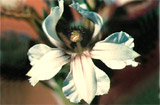
|
Streaked
goodenia,
Goodenia
calcarata.
Select the thumbnail
image or plant name for a higher resolution
image (21k).
Photo: Horst Weber
|
Years ago this section of the walk had been totally infested with feral goats. Today, I neither see nor hear one single goat. Surely, a small number would have to be around. I discover one bush showing severe recent damage but the overall situation appears to be very encouraging. This is particularly true around the area of the 4 km marker where many young Narrow-leaved fuchsia bushes (Eremophila alternifolia) obviously owe their young existence to Arkaroola's goat control measures.
|
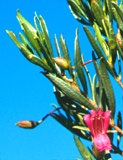
|
Narrow leaved
fuchsia bush,
Eremophila
alternifolia.
Select the thumbnail
image or plant name for a higher resolution
image (51k).
Photo: Horst Weber
|
Approaching the final section of the track, in an area of gently sloping rock slabs, another favourite plant greeted me with a single flower. This is Jockey's cap, also known as Striped mint (Prostanthera striatiflora). Numerous buds promise a more powerful display, soon.
|

|
Striped mint or
Jockey's cap,
Prostanthera
striatiflora.
Select the thumbnail
image or plant name for a higher resolution
image (30k).
Photo: Horst Weber
|
The track meets the road just after an amazing change of landscape. Quite suddenly, the mixture of medium-sized bushes, slender Rock sida and smaller, ground-covering plants is replaced by widely spaced trees. Between the Black oaks (Casuarina cristata) and Bullock bushes (Alectryon oleifolius) fist-sized stones neatly cover the ground, completely bare of any smaller vegetation as if sprayed with pesticides. Even a close inspection does not reveal much. Over the coming weeks I am to witness the occasional Ptilotus spp. pushing its way through the
rock, only to be eaten nearly faster than it can grow.
|

|
Bullock
bush, Alectryon oleifolius.
Select the thumbnail
image or plant name for a higher resolution
image (45k).
Photo: Horst Weber
|
When hill walking in Ireland it is not unusual to witness low cloud and mist rolling in over hilltops, enveloping landscape and walker. Strolling along in the soft, wafting grey it seems to blend naturally with springy turf and reed tufts and flexible heather rolling along gently curved granite. The picture is complete and without contradictions.
When the mist rolled in to Arkaroola, it took me completely by surprise. Somehow, the sharp-edged, hard and stony ground, the rocky outcrops and deep gorges were not supposed to be wrapped in this floating, grey, moist cotton. Definitely not "my" Acacia Ridge which was more or less tucked away in low cloud. Naturally, the ferns along the ridge were thriving and my skin and nostrils were definitely relieved about newly found humidity but somehow I never lost the feeling that desert rock and mist were not supposed to be together in one place.
It was during those duller days that I discovered a plant I had never seen before. About 10 m away from the track, halfway down a massive single slab of rock a Common fringe myrtle (Calytrix tetragona) had established itself a comfortable home.
|
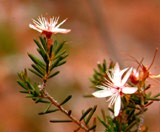
|
Common fringe
myrtle,Calytrix tetragona.
Select the thumbnail
image or plant name for a higher resolution
image (36k).
Photo: Horst Weber
|
Sharpy Coulthard of the Adnyamathanha Aboriginal people takes visitors on a Bush-Tucker Walk into Mawson Valley. This morning ten of us are eager to learn a few snippets of thousands of years of knowledge. Sharpy's calm, quiet voice carries this rare, pleasant authority from which no listener desires escape. With great ease and skill his words are swiftly weaving a comfortable net and we readily allow our attention to be caught.
Survival in the desert is built on knowledge and skill. Where and how to obtain water and food? How to avoid danger in all shapes and form? How to heal and repair when things have gone wrong? This morning we will gain a few glimpses into this complex matter.
Still in sight of the village, Sharpy's face suddenly beams with delight. A Potato bush (Solanum ellipticum) has utilised the recent rains and grown a fresh, edible fruit. The plant is similar to a Tomato bush (Solanum quadriloculatum), but the first one bears an edible fruit while the latter one is poisonous. My ears pop up when I hear the next question. Someone has been told somewhere that the plant we are looking at is a Tomato bush. Naturally, with two plants so similar, one being poisonous one edible it would be nice to know for sure. So, which is which and who is right? I have never been able to tell the two apart, so I am especially eager to hear the answer.
Sharpy asks us to inspect the branches and leaves and look for prickles. We find plenty on the branches but just a few on the leaves. This, Sharpy explains, is important. The Tomato bush will have scattered prickles along the leaves' midribs but none on the blades. Unfortunately there is no Tomato bush around to compare the two right there and then. With only one precious fruit to look at a second way of telling the nutritious from the poisonous plant cannot be explored. We would have to pick the fruit and open it. The edible one is 2-celled while the poisonous one is 4-celled.
Browsing through some literature that evening I am not surprised to find that Sharpy is right. Furthermore, one possible reason for the confusion about the plants reveals itself. The poisonous Wild tomato (S.quadriloculatum) is known by two common names, both including the word tomato (the second being Tomato bush). But the edible Velvet potato bush (S. ellipticum) bears common names like Potato bush, Wild gooseberry, Velvet nightshade, and, unfortunately, Tomato bush.
|
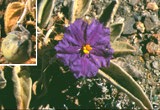
|
Potato
bush, Solanum ellipticum.
Select the thumbnail
image or plant name for a higher resolution
image (51k).
Photo: Horst Weber
|
Having seen many fruit of the Native pear on Acacia Ridge I am amazed to learn that it is actually edible. Carefully, Sharpy opens a fruit. Inside, held together by a milky, sticky substance is a cone of flat, tightly packed yellow-green seeds, not unlike lentils, but larger and pointed, also slightly curved to form the cone.
The pointed end of the cone is totally white. These are neatly and tightly packed feathery hairs, attached to each seed. While we are sampling some seeds, eagerly following Sharpy's explanations, sun and wind gradually dry out the sticky substance, detaching the seeds from each other and unfolding each seed's feathery wings, upon which they gracefully take to the air.
|

|
Fruit of the Native
pear, Leichhardtia australis.
Select the thumbnail
image or plant name for a higher resolution
image (21k).
Photo: Horst Weber
|
Four weeks later, the initial shock about dryness and dust is forgotten. Elated, I lean back into the sand at Arkaroola Waterhole. Ringing in my ears are Doris Lessing's words, spoken about Africa, yet equally true about the northern Flinders Ranges:
"That is not a place to visit
unless one chooses to be an exile ever afterwards from an
inexplicable majestic silence lying just over the border of
memory or thought ... gives you the knowledge that man is a
small creature among other creatures, in a large
landscape."
As the day comes to a close, a peregrine falcon performs his skilled aerobatics amidst an enthralling, dust-free light show of deep-red cliffs, dark blue sky and brave Native pines (Callitris glaucophylla) clinging to narrow crevices above a perfectly still waterhole.
|
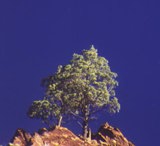
|
Native
pine, Callitris glaucophylla.
Select the thumbnail
image or plant name for a higher resolution
image (18k).
Photo: Horst Weber
|
References
- Barker, S., et al., Explore the Flinders Ranges, Royal Geographical Society (S.A.)
- Lessing, Doris, Collected African Stories, Triad Grafton
- Sprigg, R.C (1984), Arkaroola-Mount Painter - The Last Billion
Years, Lutheran Publishing
House, Adelaide.
Horst Weber is a teacher and
IT-manager at the German Cultural Institute, Goethe-Institut
in Dublin, Ireland. For more
than 10 years he has been fascinated with arid Australia and
he is particularly fond of the Flinders Ranges and
Arkaroola. During his field work in 1997 he collected data
for a small book on plant profiles. Horst thanks the
AUSTRALIAN
GEOGRAPHIC, Singapore
Airlines, Arkaroola Pty. Ltd. and
Flair Travel (Dublin) for their support.

[Front Page] [Features] [Departments] [SGAP Home Page] [Subscribe]
Australian Plants online - September 1998
The Society for Growing Australian Plants
|